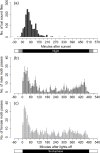Early erratic flight response of the lucerne moth to the quiet echolocation calls of distant bats
- PMID: 30125318
- PMCID: PMC6101402
- DOI: 10.1371/journal.pone.0202679
Early erratic flight response of the lucerne moth to the quiet echolocation calls of distant bats
Abstract
Nocturnal insects have evolved ultrasound-sensitive hearing in response to predation pressures from echolocating insectivorous bats. Flying tympanate moths take various evasive actions when they detect bat cries, including turning away, performing a steering/zigzagging flight and ceasing flight. In general, infrequent ultrasonic pulses with low sound intensities that are emitted by distant bats evoke slight turns, whereas frequent and loud ultrasonic pulses of nearby bats evoke erratic or rapid unpredictable changes in the flight path of a moth. Flight cessation, which is a freezing response that causes the moth to passively dive (drop) to the ground, is considered the ultimate last-ditch evasive behaviour against approaching bats where there is a high predation threat. Here, we found that the crambid moth Nomophila nearctica never performed passive dives in response to frequent and loud ultrasonic pulses of >60 dB sound pressure level (SPL) that simulated the attacking echolocation call sequence of the predominant sympatric insectivorous bat Eptesicus fuscus, but rather turned away or flew erratically, regardless of the temporal structure of the stimulus. Consequently, N. nearctica is likely to survive predation by bats by taking early evasive action even when it detects the echolocation calls of sympatric bats hunting other insects at a distance. Since aerially hawking bats can track and catch erratically flying moths after targeting their prey, this early escape strategy may be common among night-flying tympanate insects.
Conflict of interest statement
The authors have declared that no competing interests exist.
Figures




Similar articles
-
High duty cycle pulses suppress orientation flights of crambid moths.J Insect Physiol. 2015 Dec;83:15-21. doi: 10.1016/j.jinsphys.2015.11.004. Epub 2015 Nov 5. J Insect Physiol. 2015. PMID: 26549128
-
Ultrasound avoidance by flying antlions (Myrmeleontidae).J Exp Biol. 2018 Oct 29;221(Pt 21):jeb189308. doi: 10.1242/jeb.189308. J Exp Biol. 2018. PMID: 30224368
-
Surviving cave bats: auditory and behavioural defences in the Australian noctuid moth, Speiredonia spectans.J Exp Biol. 2008 Dec;211(Pt 24):3808-15. doi: 10.1242/jeb.023978. J Exp Biol. 2008. PMID: 19043053
-
Evolutionary escalation: the bat-moth arms race.J Exp Biol. 2016 Jun 1;219(Pt 11):1589-602. doi: 10.1242/jeb.086686. J Exp Biol. 2016. PMID: 27252453 Review.
-
Sound strategies: the 65-million-year-old battle between bats and insects.Annu Rev Entomol. 2012;57:21-39. doi: 10.1146/annurev-ento-121510-133537. Epub 2011 Aug 29. Annu Rev Entomol. 2012. PMID: 21888517 Review.
Cited by
-
Sustainable pest control inspired by prey-predator ultrasound interactions.Proc Natl Acad Sci U S A. 2022 Oct 25;119(43):e2211007119. doi: 10.1073/pnas.2211007119. Epub 2022 Oct 10. Proc Natl Acad Sci U S A. 2022. PMID: 36215520 Free PMC article.
References
Publication types
MeSH terms
LinkOut - more resources
Full Text Sources
Other Literature Sources
Miscellaneous

